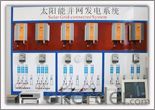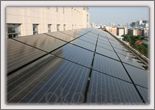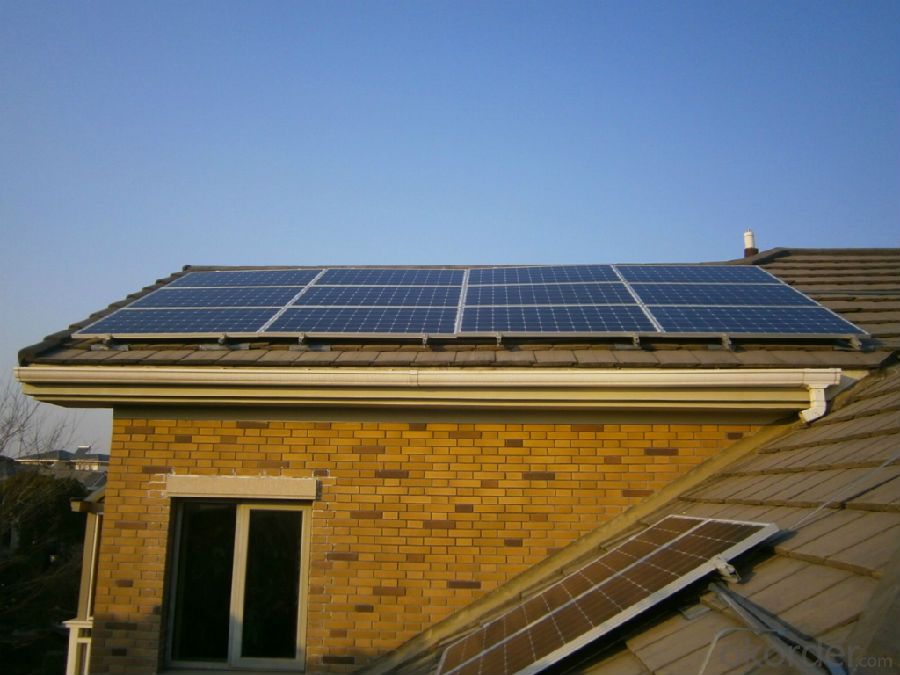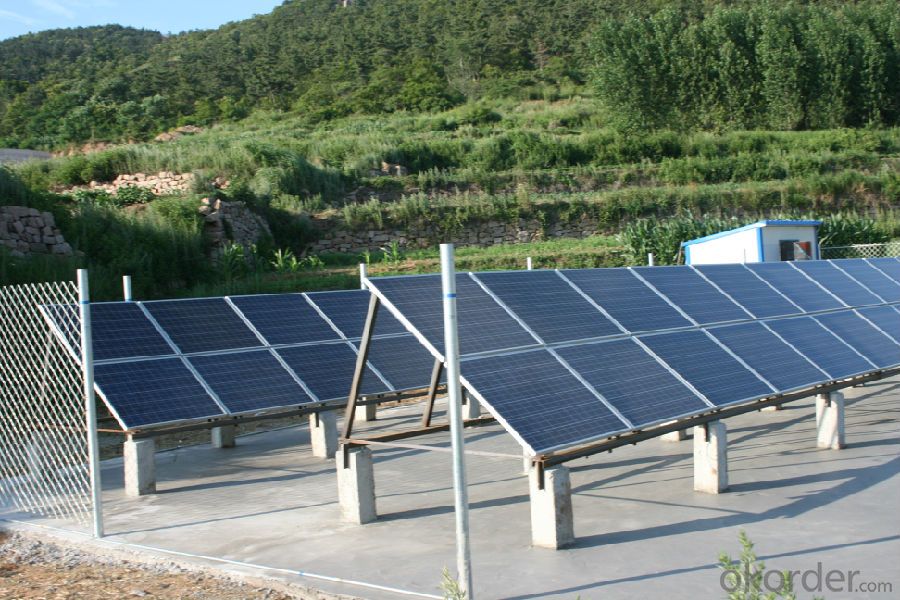Solar On Grid Inverters, Grid Tied Solar Inverter
- Loading Port:
- Shekou
- Payment Terms:
- TT or LC
- Min Order Qty:
- 20 unit
- Supply Capability:
- 800000 unit/month
OKorder Service Pledge
OKorder Financial Service
You Might Also Like
Solar On Grid Inverters, Grid Tied Solar Inverter
Products
Solar On Grid Inverter controls the whole system. Solar Inverters converts the DC current produced by the solar array into AC current, then the Solar On Grid Inverters transfers AC current to the grid, and adjusts the operation point in real-time according to the variation of sunshine to realize the maximum power point tracking (MPPT).
Success Stories


Technical Features
Adopting the dynamic VI MPPT method which has independent intellectual property; fast response and stable operation.A modified anti-islanding detection method can effectively shorten the detection time whilst keeping a high power quality, remove the obstacles to the grid, and suitable for a multi-inverter system.
Digital control with full automatic running, data storage and completely protective function.
Save the daily operating data automatically and consult the operating data for 8 years. It is convenient for statistics and analysis.
Dormancy function, save energy and reduce abrasion.
New design of anodized aluminum case; pretty appearance; perfect cooling and shielding.
Through optimization of the design, On Grid Inverters is adopted with free cooling instead of fans, and then the Solar Home will reduces the maintenance costs.
Light in weight, small in size, flexible installation.
Product Specifications
| Model | GB1000B | GB1500B | GB2000B | GB2500B | GB3000B | GB4000B | GB5000B |
| DC Input | |||||||
| Max. Input Power | 1200 W | 1700W | 2300 W | 2800W | 3400W | 4500W | 5600W |
| Max. Open-Circuit Voltage | 400 V | 450 V | |||||
| Recommended MPP Voltage Range | 160 ~ 320 V | 160 ~ 360 V | |||||
| Max. Input Current | 7A | 8A | 10A | 11A | 12A | 16 A | 20A |
| Reverse Olarity Protection | Yes | ||||||
| Input Current Limit Protection | Yes | ||||||
| AC Output | |||||||
| Rated Output Power | 1000 W | 1500W | 2000 W | 2500W | 3000 W | 4000 W | 5000 W |
| Max. Output Power | 1100 W | 1650W | 2200 W | 2750W | 3300 W | 4400 W | 5500 W |
| Mains Voltage/Frequency | 230 V / 50Hz | ||||||
| Power Factor | >0.99 | ||||||
| Harmonic Distortion of Current | < 4% | ||||||
| Max. Efficiency | 95.00% | 95.00% | 95.20% | 95.20% | 95.30% | 96.10% | 96.20% |
| Efficiency In Europe | 94.10% | 94.10% | 94.40% | 94.40% | 94.50% | 95.20% | 95.40% |
| Anti-Islanding Protection | Yes (with National Patent) | ||||||
| Short Circuit Protection | Yes | ||||||
| Common Data | |||||||
| Isolation | No transformer | ||||||
| Protection Degree | IP52 | ||||||
| Cooling | Free convection cooling | ||||||
| Operating Temperature | -10 ℃ ~ +50 ℃ | ||||||
| Operating Humidity | 0 ~ 95 % | ||||||
| Communication Interface | RS232/RS485 | ||||||
| Dimensions(W*H*D) | 250*310*165mm | 250*310*200mm | 310 * 400 * 235 mm | ||||
| Weight (KG) | 8 | 8 | 9.5 | 9.5 | 10 | 17 | 17.5 |
| Certification | |||||||
| Applicable Safety Standard | EN 50178 | ||||||
| EMC | EN61000-3-2,EN61000-3-3,EN61000-6-1,EN61000-6-3 | ||||||
| Grid Monitoring | UL 1741,IEEE 929,VDE0126-1-1 | ||||||
| Warranty Period | 5 years | ||||||



- Q:Can I connect solar panels directly to the grid without an inverter?
- No, you cannot connect solar panels directly to the grid without an inverter. An inverter is necessary to convert the DC (direct current) output from solar panels into AC (alternating current) that is compatible with the grid.
- Q:How does a solar inverter communicate with other devices?
- A solar inverter communicates with other devices through various communication protocols such as Wi-Fi, Bluetooth, Ethernet, or RS485. These protocols allow the inverter to connect and exchange information with devices such as monitoring systems, smart meters, or home automation systems. This communication enables real-time monitoring, data logging, and control of the solar energy system.
- Q:How does a solar inverter impact the overall system reliability?
- A solar inverter plays a crucial role in the overall system reliability of a solar power system. It converts the direct current (DC) generated by solar panels into alternating current (AC) that can be used to power homes and businesses. By efficiently managing the power output and ensuring proper voltage levels, a solar inverter helps maintain the stability and reliability of the system. It also includes protective features that safeguard the system from potential issues like overvoltage, overcurrent, and short circuits. Therefore, a high-quality solar inverter positively impacts the overall system reliability by ensuring optimal performance and protecting against potential faults or failures.
- Q:Can a solar inverter be used with solar-powered desalination systems?
- Yes, a solar inverter can be used with solar-powered desalination systems. A solar inverter is essential in converting the direct current (DC) power generated by solar panels into alternating current (AC) power that can be used to operate the desalination system. This allows for the efficient utilization of solar energy for powering the desalination process.
- Q:What certifications should a solar inverter have?
- A solar inverter should have certifications such as UL 1741, IEC 62109, and IEEE 1547 to ensure its safety, reliability, and compliance with industry standards. Additionally, certifications like ISO 9001 and ISO 14001 can demonstrate the manufacturer's commitment to quality and environmental management.
- Q:Can a solar inverter be used with dual-axis solar trackers?
- Yes, a solar inverter can be used with dual-axis solar trackers. The dual-axis solar trackers continuously adjust the position of the solar panels to optimize sun exposure throughout the day. The solar inverter is responsible for converting the DC power generated by the solar panels into AC power for use in residential or commercial applications. Therefore, the solar inverter can be easily integrated with dual-axis solar trackers to ensure efficient power generation and utilization.
- Q:Are solar inverters weather-resistant?
- Yes, solar inverters are designed to be weather-resistant. They are typically built with durable materials and sealed enclosures to protect them from various weather conditions such as rain, snow, and extreme temperatures. However, it is always recommended to consult the manufacturer's specifications and guidelines to ensure proper installation and maintenance for optimal performance and longevity.
- Q:Can a solar inverter be used in locations with high humidity or extreme temperatures?
- Yes, solar inverters are designed to withstand high humidity and extreme temperatures. They are built with robust materials and protective coatings to ensure reliable operation in various environmental conditions. Additionally, many solar inverters undergo extensive testing and are certified to meet industry standards for performance and durability in challenging climates.
- Q:Can a solar inverter be used in areas with high levels of electromagnetic interference (EMI)?
- Yes, a solar inverter can be used in areas with high levels of electromagnetic interference (EMI) as long as the inverter is designed and tested to withstand such conditions. Inverters with robust shielding and advanced filtering mechanisms can effectively mitigate the effects of EMI, ensuring stable and reliable operation even in challenging electromagnetic environments.
- Q:Can a solar inverter be used with building-integrated photovoltaic systems?
- Yes, a solar inverter can be used with building-integrated photovoltaic systems. The solar inverter converts the direct current (DC) electricity generated by the photovoltaic panels into alternating current (AC) electricity that can be used to power the building or be fed into the grid.
1. Manufacturer Overview |
|
|---|---|
| Location | |
| Year Established | |
| Annual Output Value | |
| Main Markets | |
| Company Certifications | |
2. Manufacturer Certificates |
|
|---|---|
| a) Certification Name | |
| Range | |
| Reference | |
| Validity Period | |
3. Manufacturer Capability |
|
|---|---|
| a)Trade Capacity | |
| Nearest Port | |
| Export Percentage | |
| No.of Employees in Trade Department | |
| Language Spoken: | |
| b)Factory Information | |
| Factory Size: | |
| No. of Production Lines | |
| Contract Manufacturing | |
| Product Price Range | |
Send your message to us
Solar On Grid Inverters, Grid Tied Solar Inverter
- Loading Port:
- Shekou
- Payment Terms:
- TT or LC
- Min Order Qty:
- 20 unit
- Supply Capability:
- 800000 unit/month
OKorder Service Pledge
OKorder Financial Service
Similar products
New products
Hot products
Hot Searches
Related keywords


































